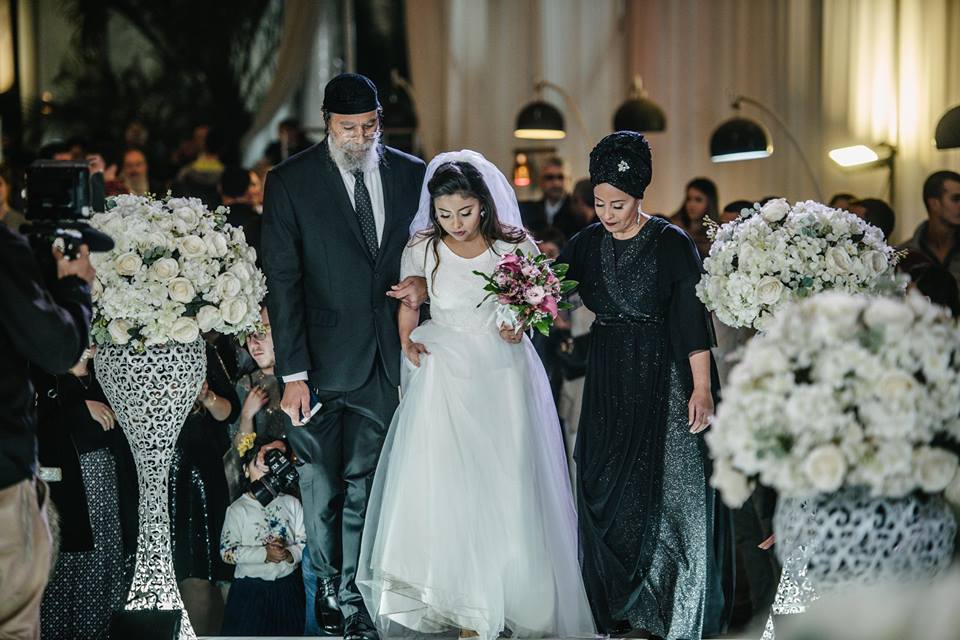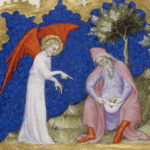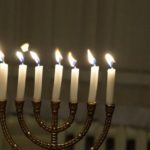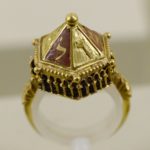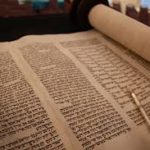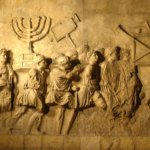Genesis 2:18 says, “It is not good for humanity to be alone.” We are designed to long for loving companionship, to cling to each other and become “one flesh” (Genesis 2:24). The Hebrew word for marriage is kiddushin from the root kadosh, meaning holy. In Judaism, we sanctify our relationship through the marriage ceremony.
A Little History
Contemporary Jewish weddings are a combination of two ancient and separate ceremonies. In Talmudic times the erusin (similar to an engagement or betrothal) would take place up to a year in advance of the nisuin (the actual marriage). At the erusin (literally “forbidden,” as in the bride and groom were forbidden to others) the couple signed a document of the agreement; the bride accepted an item of value from the groom, usually a coin or a ring; and the blessing over the wine was recited. The couple were legally married but did not consummate the marriage and lived separately for up to a year, during which time the couple prepared a home for their new family. The nisuin was a festive ceremony when the groom escorted the bride to his home. Blessings were recited over wine and the couple were left alone together to consummate the marriage.
Today, the erusin and nisuin are combined into one ceremony.
Before the Ceremony
Aufruf
It is customary for the groom to be called to the Torah for an aliya on the Shabbat immediately prior to the ceremony. This ceremony is known by the Yiddish term, aufruf. In non-Orthodox synagogues, the bride will be called as well. After the couple recites the Torah blessings, the rabbi says a special prayer for the couple. Following the aliya, the congregation wishes the family mazal tov, sometimes showering the couple with candy to wish them a sweet life together.
Mikve
On the night before the wedding, especially in Orthodox communities, the bride and some of her family and friends visit the mikve, the ritual bath. Here, the bride will focus in prayer on her love for her husband, her prayers for their marriage and her joy in the moment. She may choose to repeat this ritual on a monthly basis, in keeping with Jewish laws regarding family purity and sexual relations. Men, too, may benefit from this unique type of spiritual cleansing.
Fasting
It is traditional for the bride and groom to fast on the day of the wedding. On this day, God forgives the bride and groom their previous sins, so that they can begin their life together fresh and new. Thus, the bride and groom treat this day as a private Yom Kippur.
The Ceremony
The ceremony can take place on any day except Shabbat or a festival. It may be held anywhere, although many couples choose the synagogue.
The Ketuba
Sometime before the wedding, the couple should select a ketuba, a marriage contract which outlines the nature of the commitment they make to each other. The couple also should choose two friends (unrelated to the couple or to one another) for the honor of signing the ketuba. Just before the ceremony, the ketuba is signed by these two witnesses.
In ancient times, when most cultures regarded women as little more than property, the Jewish ketuba was quite advanced. In a world where most women could not own property or inherit, the ketuba was a legal marriage contract that protected the rights of and provided financially for the wife in case of divorce or the death of the husband.
Today, when the dispensation of property is provided for by civil law, the ketuba is often a modified version, stressing the personal obligations of marriage rather than the financial ones.
Contemporary ketubot reflect a wide variety of artistic and linguistic styles. Many couples choose to engage an artist to create a uniquely personal ketuba.
Veils and Bedeken
The Torah describes how, at the initial meeting between Rebecca and Isaac, Rebecca lowers her veil as a sign of modesty as she comes forward to meet her intended. Ever since then, it has become traditional for Jewish brides to wear a veil during the wedding ceremony.
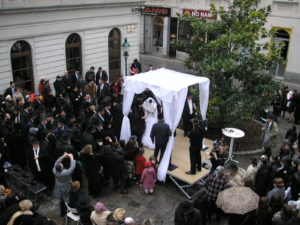 Prior to the wedding, perhaps associated with the signing of the ketuba, the couple will be seated facing each other and the groom has an opportunity to lower the veil over his bride’s face, a ritual called bedeken. The Torah says that Isaac’s son, Jacob, was deceived into marrying Leah rather than his beloved Rachel because he didn’t recognize her due to her heavy veil. The custom of bedeken allowed the groom to confirm that the bride was his intended.
Prior to the wedding, perhaps associated with the signing of the ketuba, the couple will be seated facing each other and the groom has an opportunity to lower the veil over his bride’s face, a ritual called bedeken. The Torah says that Isaac’s son, Jacob, was deceived into marrying Leah rather than his beloved Rachel because he didn’t recognize her due to her heavy veil. The custom of bedeken allowed the groom to confirm that the bride was his intended.
Today, the tradition is interpreted as a reminder that, while we put on our most beautiful face for each other at the wedding, each person has 70 levels, just like the Torah. It is a critical moment to remind ourselves that we are marrying all 70 levels. Tradition also suggests that it is at this time that the bride will be blessed with special “mother’s eyes” with which she will watch over the future children with whom the couple may be blessed.
The Khuppa
Following the signing of the ketuba, the wedding party goes to the place where the ceremony will occur and where the khuppa, the wedding canopy, has been set up.
The khuppa has four poles and a cover to form a roof, symbolizing the new house the bride and groom will create. It can be quite elaborate or as simple as a tallit (prayer shawl) on four poles. (It is customary for the bride to present the groom with a tallit as a wedding gift, which can then be used as the khuppa.) The khuppa has no walls, symbolizing the open-ness which we hope will characterize the marriage, and it is surrounded by the family and friends who will support this new relationship. Although the khuppa is a temporary structure, it represents our hope for permanence and security in the new home which the couple is building together.
The Procession
The rabbi and/or cantor may either walk down the aisle or wait for the wedding party under the khuppa. The bridesmaids, groomsmen, best man and maid or matron of honor follow. Next the groom appears and, finally, the bride. In traditional ceremonies, both the groom and the bride are escorted down the aisle by their parents, who stand beside them during the ceremony.
Seven Circles
After a brief greeting by the rabbi, the bride will circle the groom seven times, usually with her mother and mother-in-law (sometimes her bridesmaids) holding her train. This ritual symbolizes that the bride is now entering the groom’s sphere and he is her focal point. In a spirit of egalitarianism, contemporary grooms often choose to circle their brides as well. Sometimes the bride and groom circle one another while holding hands. Then they stand side-by-side before the rabbi under the khuppa, with the bride to the groom’s right.
Birkat Erusin
The rabbi then recites the birkat erusin, the engagement blessing, over a cup of wine. The rabbi hands the cup to the groom, then to the bride, and the couple share a sip of the wine, symbolic of joy and celebration in Jewish tradition. The cup is filled to overflowing, as we hope and pray that the lives of the bride and groom will overflow with blessing. If the parents are present, the rabbi gives the cup to the groom’s father, who raises it to his son’s lips, then hands it to his wife, who raises it to the bride’s.
The Ring
The groom then places a ring on the right finger of his bride and recites the formula, “With this ring, you are made holy to me according to the law of Moses and Israel.”
 The right forefinger is considered the most prominent, enabling the witnesses to see his commitment. In a traditional wedding, only the groom presents a ring to the bride, but it is customary in non-Orthodox communities for the bride to give a ring to the groom, as well, and to repeat the same words.
The right forefinger is considered the most prominent, enabling the witnesses to see his commitment. In a traditional wedding, only the groom presents a ring to the bride, but it is customary in non-Orthodox communities for the bride to give a ring to the groom, as well, and to repeat the same words.
Traditionally, the ring is a plain gold band unadorned with stonesto prevent the possibility of fraud. The ring must belong outright to the groom; if it is a gift or an heirloom, he should pay a nominal fee to “purchase” it.
Reading the Ketuba
The next ritual is the reading of the ketuba. Then the ketuba is handed to the groom, who gives it to the bride.
Sheva Brakhot
Next comes the sheva brakhot, the seven traditional blessings, which are said over a second cup of wine. We pray that each day of the couple’s life together will be filled with blessing. The blessings may be read in English in addition to Hebrew. Family and friends may be asked to read the translations. In these blessings, we praise God as the Creator of humanity and note that all of creation joins us in praising God. We are reminded that we are created in the Divine image and we invoke the energy of the land of Israel. We express our hope that this couple will be as happy as Adam and Eve were in the Garden of Eden, and conclude by wishing the couple joy, gladness, song, delight, harmony, peace, companionship and all good things.
At this point the Rabbi may offer a few words directed uniquely to this couple. In addition, wedding guests or members of the wedding party may contribute poems, songs or readings.
Breaking the Glass
The ceremony concludes with the breaking of a glass. While it is customary for the groom to break the glass, the bride may decide to break a glass as well. The breaking of a glass is a reminder of our connection to Jewish history. Originally symbolic of the destruction of the Temple, we become aware at this point of what has gone before us and of the ephemeral nature of our existence, the broken-ness of our world and our responsibility to participate in its repair. We note that marriage is fragile, like glass, and just as difficult to put back together once it is broken. We remind the couple once more of the importance of treating each other with care, of always choosing kind words and of protecting the holiness of their relationship. The glass is broken and cries of “Mazal tov” are heard.
Yikhud
Historically, yikhud was the time when the bride and groom were left alone to consummate the marriage. Today, the couple retreats for a few minutes of private time where they can experience the wonder of the first moments of their marriage together, away from the well-wishers, photographers, parents and others. The yikhud is an important rite. It is critical that the couple establish the precedent that, from now on, they are each other’s top priority. While alone, they may break their fast together.
Seudat Mitza
The celebration continues with a seudat mitzva, a celebratory meal. The wedding reception is joyous occasion of music, dancing, speeches from guests and family and, of course, a festive dinner. At the conclusion of the dinner, the sheva brakhot are again recited.
After the wedding and reception, most Jewish newlyweds leave on a honeymoon. Orthodox couples spent the following week in further celebration; each evening they attend dinners given by their friends at which the sheva brakhot are repeated.
In Conclusion
Reb Nakhman of Bratslav comments that people come to a wedding and then they walk out. One says, “It was a beautiful wedding, I liked the food.” Another says, “I liked the music.” A third says, “I met a lot of good friends there.” According to Reb Nakhman, those people were not really present at the wedding. Then someone walks out and says, “Barukh HaShem, thank God those two got together.” That person was truly present at the wedding. May we all merit to share the mitzva of mesameakh khatan v’kalla, causing the bride and the groom to rejoice.

